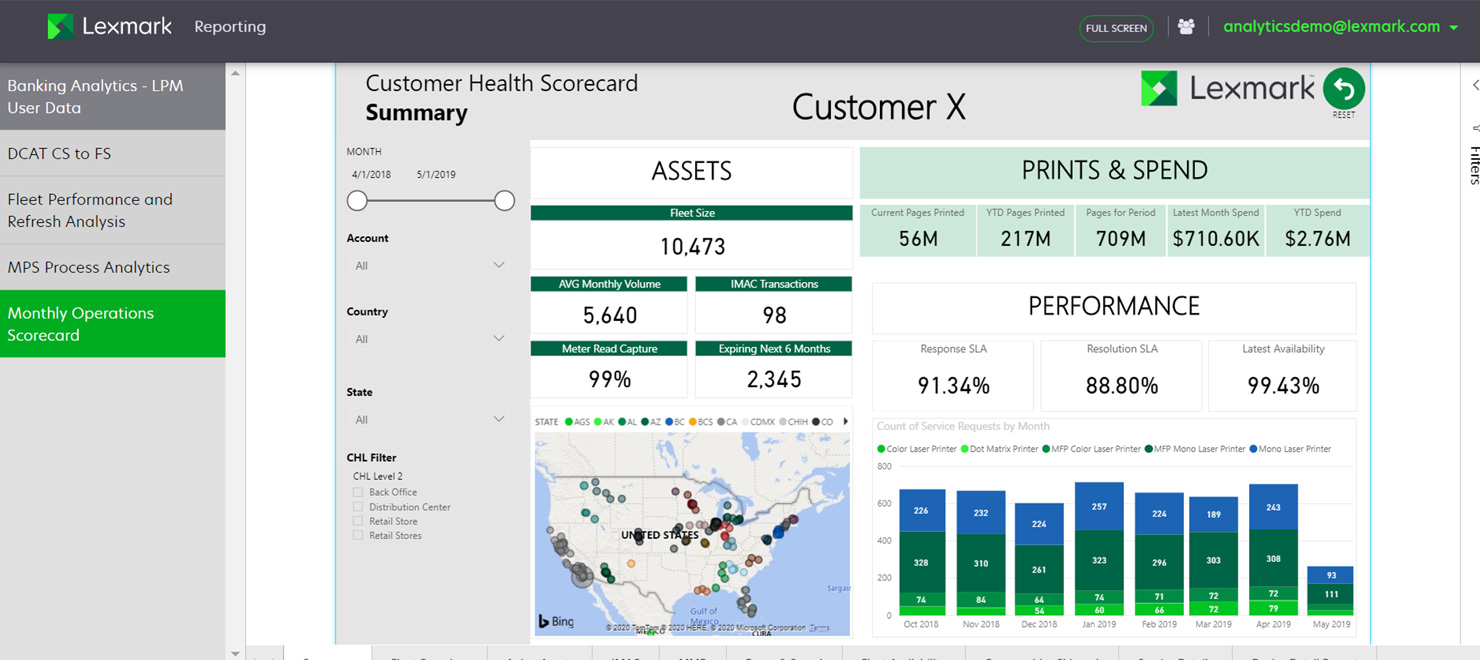Lexmark Blog
Managed Print Services (MPS)
Interactive analytics: Empowering MPS customers with business intelligence
Lexmark’s approach to managed print services analytics helps customers use data to improve their business

TAGS: Managed Print Services (MPS), Analytics
Every Lexmark managed print services (MPS) customer gets access to Lexmark interactive analytics, allowing IT managers to see—and take action on—everything from an overview of their printing and scanning ecosystem down to the smallest details of hardware and processes. We talked with Greg House, senior manager, Lexmark professional services, about the capabilities of interactive analytics, the expertise of the people who bring its data to life, and what makes this combination so powerful for MPS customers.
Is Lexmark interactive analytics basically reporting—some charts, graphs and spreadsheets showing how many pages a customer has printed?
No. But because that’s all that many MPS vendors offer, that’s what many enterprise buyers have come to expect. Lexmark has gone far beyond the limitations of static charts and spreadsheet data dumps, where you have to figure out everything on your own. In fact, as part of our best-in-class governance model, Lexmark has revolutionized MPS analytics through dynamic data visualizations and the application of business intelligence.
What does that mean?
We’ve developed a form of exploratory analytics that helps turn data into action, enabling an interactive self-service experience that lets organizations decide what they want to focus on. Our web-based interface lets you drill down to any aspect of print data you want to understand and uncovers its relationship to other parts of the business. It’s about exploring your data visually, from the highest levels of organizational hierarchy down to details about individual devices, all based on continually updated information. I call it “choose your own adventure”—and we’re the only ones who have it.

What are enterprise MPS customers you talk to getting with their current vendors, and not getting with their current vendors’ analytics?
Most of them are getting basic reporting on services like asset management, billing and service calls. And every month they’re getting a presentation file or spreadsheet of print data. But many vendors simply provide their own off-the-shelf tools for asset management. The customer can pull reports or see various predefined views—but there’s no business intelligence, no configurability for their unique needs. There’s nothing tailored to their industry—no benchmarks against industry averages and best practices, no trending, no outlier analysis, no integration with external data. They simply don’t offer the insights and options that Lexmark interactive analytics provides to our MPS customers.
They’re not getting the dynamic data experience of Lexmark interactive analytics—data that they can interact with and learn from without creating another report or going back to the MPS provider for additional details.
What do you mean by external data?
Being able to bring in data from their own existing systems or just about any private or publicly available data set gives Lexmark MPS customers the ability to create new business insights and hypotheses. Each customer and industry has their own relevant business metrics. For example, a healthcare provider might want to see something like pages printed per emergency room visit. Why would different emergency departments, which have the same type of processes, exhibit inconsistent printing behaviors? Integrating external data—store revenue, shipping costs, weather, just about anything—enables Lexmark and the customer to perform a root cause analysis that drives better compliance and efficiency.
That’s the advantage of an interactive analytics platform like Lexmark’s: We can combine printing with virtually any data set for true clarity and understanding.
You mentioned industry-specific analytics...
We have MPS experts in banking, government, healthcare, insurance, education, manufacturing and retail. Our experts come from those industries, know those industries, and have lived in the shoes of our customers. That experience gives us a unique view into the processes, challenges and regulatory requirements of each industry, helping us uncover inefficiencies and new ways for our customers to save time and money. This industry expertise is something that Lexmark has excelled at for decades.
It sounds like other vendors offer a sort of “do-it-yourself” tool set, while Lexmark is more hands-on with customers. Can you expand on that?
Yes, it’s one thing to say you’re committed to your customers, but our goal is to understand their goals, to help them reach some future desired state. We don’t just drop a solution in, run away, and come back five years later when the next RFP goes out. We are in there on a monthly or quarterly basis, making sure that if the customer expected to achieve 20% cost savings, for example, they’re on track to hit that target. There’s a hidden goldmine of process improvement and cost savings when you have a mature provider like Lexmark helping you uncover the right data points.
It is common for devices to creep back into an organization after the print fleet has been optimized. It’s possible for pages and old habits to return. So without the focus, tracking and evidence that Lexmark interactive analytics provides, it’s easy to go back to inefficient, costly practices. With our robust data mining tools, data scientists, industry expertise, and decades of experience, we’re constantly driving our customers toward a best-practice standard.
The way we do MPS, we’re not just a vendor—we’re a partner committed to our customers’ long-term success.
Want to experience the power of Lexmark interactive analytics?